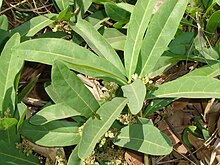Dichapetalum cymosum
| Gifblaar | |
|---|---|
 |
|
| Scientific classification | |
| Kingdom: | Plantae |
| (unranked): | Angiosperms |
| (unranked): | Eudicots |
| (unranked): | Rosids |
| Order: | Malpighiales |
| Family: | Dichapetalaceae |
| Genus: | Dichapetalum |
| Species: | D. cymosum |
| Binomial name | |
|
Dichapetalum cymosum (Hook.) Engl. |
|
Dichapetalum cymosum, commonly known as Gifblaar from Afrikaans, or occasionally its English translation, poison leaf, is a small prostrate shrub occurring in the northern parts of Southern Africa. It is notable as a common cause of lethal cattle poisoning in this region and is considered one of the 'big 6' toxic plants of cattle in South Africa. A 1996 estimate of plant poisonings in South Africa attributes 8% of cattle mortality caused by poisonous plants to gifblaar. The majority (70%) of fatal cases are in Limpopo province, with 10% each in North West, Mpumalanga, and Gauteng. Fluoroacetate (the poison used to synthetically produce Compound 1080) occurs in all parts of the plant and is responsible for the toxic effects shown.
Dichapetalum cymosum was first recognised as toxic by the early Voortrekkers entering the Transvaal, who were probably alerted to its lethality by natives living in the region.
Above ground, the plant is seen as a clump of small, woody shrubs about 15 cm (6 in) high. Such a clump is typically a single plant, as gifblaar has a huge underground root system - likened to an underground tree - and sends numerous shoots above ground in favourable conditions. The most obvious above ground parts are the leaves - simple, alternate with initially fine hairs later becoming glabrous. The leaves are bright green in colour on both sides. The secondary veins form loops and do not reach the margin. The flowers are small and white, and occur as dense clumps in the early spring. Fruit formation is rare; the fruits are orange and leathery, are not poisonous and known to be consumed by the Bushmen.
Identification of gifblaar in the field is important in prevention of toxicity and also in assigning gifblaar as the cause of toxicity in an outbreak. It is a small, low-growing, nondescript shrub and thus easily confused with other species. There are four principal "confusers" in its habitat. These are Ochna pulchra (lekkerbreek) saplings, Parinari capensis (grysappel), Pygmaeothamnus spp. (goorappels) and the various gousiektebossies (various genera and species of the family Rubiaceae). The first three of these are non-toxic, but gousiektebossies are also toxic and another of the 'big 6' cattle poisons.
...
Wikipedia

